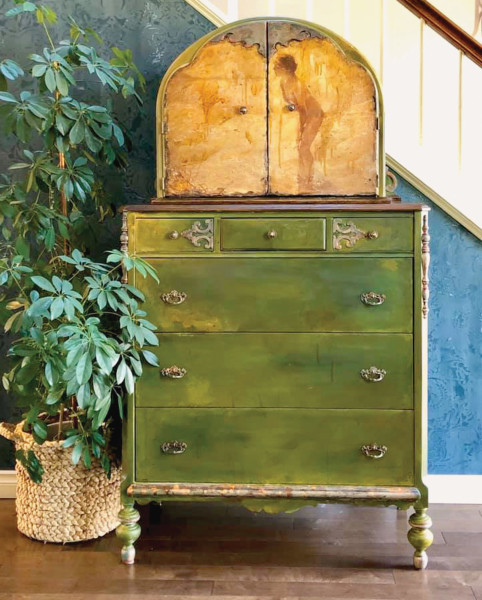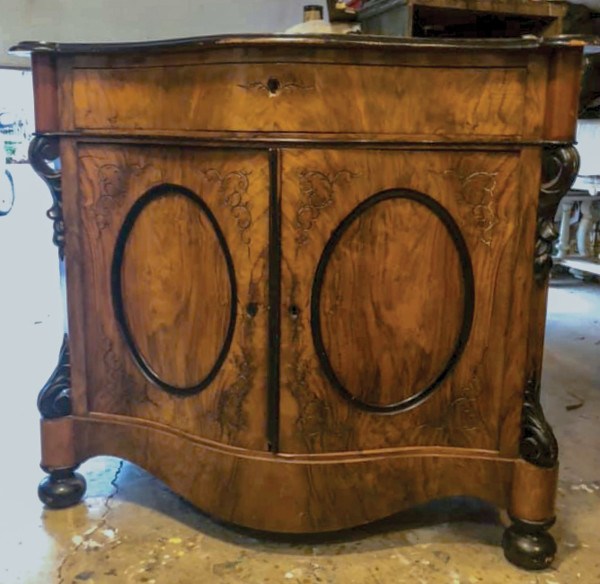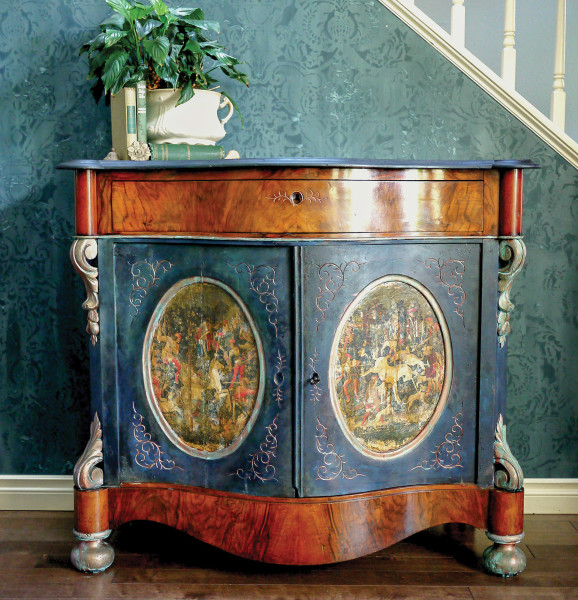Diane Llewellyn Grover wasn’t always a furniture artist. In fact, she’s a clinical social worker. Painting became a preferred form of relaxation. She began experimenting with tired old furniture, transferring pre-Raphaelite and Impressionist art prints onto drawers or door fronts, then painting the pieces. Shown here is a dull bonnet dresser she updated with a print of the nymph from “September Morn” by Paul Emile Chabas (1911) and glazed green paint. When friends starting asking for reclaimed furniture, her business The Paint Factory was born: thepaintfactorypdx.com

The furniture is “functional art”—clients have used refurbished pieces as a linen cupboard and even as a display case in a bridal store.
The Project Process
1. SELECTION
Grover looks for vintage pieces past their prime, usually with good solid construction but damage to the finish. She avoids restoration, preferring to leave minor imperfections; if there’s a crack, she’s more likely to emphasize it than fill it.
2. PREPARATION
Cleaning begins with a 50/50 mix of white vinegar and water. Grover cautions that, when working with mahogany, a base coat of primer may be needed as tannins may bleed through the paint. With mahogany, she likes to apply a coat of Wise Owl clear primer.
3. ART TRANSFER
Transfer is different from decoupage. Here, you start with a copyright-free image, photocopied on a laser printer (not ink jet) and mirror image or flipped for transfering. Laser printers print up to 11″x17″; for bigger images, copy in 11″x17″ sections, then piece together prior to transfer. (Office Depot will do this for you.) White paint is applied to the cleaned area where a print will be placed. When it’s dry, a thin layer of transfer gel is applied over the paint, and the print placed face down onto the gel. Any air bubbles are gently pressed out and the print allowed to dry overnight.

Unloved vintage furniture awaits conversion to art.
The paper backing is then removed by wetting with water, then gently and slowly rubbing away the pulp, with care not to disturb the transferred image underneath. Sometimes four applications of water may be needed to remove the backing.
4. PAINTING
Grover chooses paint colors to coordinate with the image. Her favorites, all chalk/mineral paints from Wise Owl Paint, include Spanish Olive, Foxtrot, Turmeric, and Golden Rod. She often blends colors together for more depth and interest. When paint is dry, Grover uses several thin coats of glaze to achieve her “watercolor effect.” Finally, the piece is coated with Wise Owl Matte Sealer, and the interior wiped with Furniture Salve to deodorize, condition, and seal the wood.

The old Danish cabinet, enlivened with scenes from the Unicorn Tapestries.







